 W
WSultan Abu al-'Ila Mosque is one of the most famous mosques in Islamic Cairo in Egypt. The mosque now bases on 23 pure white marble columns. The platform is a masterpiece made of Indian teak. The roof is plated in gold leaf with amazing tiny trappings. Inside walls and domes are decorated with Islamic-colored inscriptions. The dome at the outside like all Mamluks' age is made of stone.
 W
WThe Al-Ashraf Mosque or the Mosque-Madrasa of Sultan al-Ashraf Barsbay is a historical complex of mosque and madrasa located in Cairo, Egypt. The mosque was built during the Mamluk period by the Burji Sultan Al-Ashraf Al-Barsbay. The complex consists of a mosque-madrasa, mausoleum, and Sufi lodgings. The mosque is characterized by its design, which incorporates marble and stained-glass windows.
 W
WAl-Burdayni Mosque is a mosque in Cairo, Egypt. It is located in Al-Dawoudia, near the Mosque of al-Malika Safiyya. It was built by a wealthy merchant, Kareem al-din al-Bardayni in 1616 during the Ottoman rule. The building is made of stone and has gates erected in 1629 on two sides on the west, right of the fountain. This mosque was built under Ottoman rule after the Ottomans defeated the Mamluks in 1517 and ruled over Egypt until 1867. The mosque is built in Mamluk style not Ottoman style which would have been the prevailing style of choice at the time. This is because Karim al-Din al-Burdayni did not align himself with the cultural practices of the Turks neither the Egyptians.
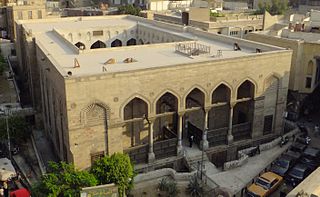 W
WThe Mosque of Al Salih Tala'i is a late Fatimid-era mosque built by the vizier Tala'i ibn Ruzzik in 1160. It is located south of Bab Zuweila, just outside the southern entrance to the old walled city of Cairo.
 W
WAmir Jamal al-Din al-Ustadar Mosque is a historic mosque in the city of Cairo. It is located inside Islamic Cairo, facing the Al-Tambakshiya Street to the north and the Habas al-Rahb Street to the southeast.
 W
WAmir Khayrbak Funerary Complex, Mosque-Madrasa of Al-Amir Khair Bak or Khayrbak Mosque is a religious complex at Bab al-Wazir street, Islamic Cairo, Egypt. It originally consisted of a mausoleum established by the Ottoman governor of Egypt Khayr Bak in 1502 CE. Later he added a madrasa and a mosque, and annexed the adjacent Amir Alin Aq Palace which was used by him as residence. On the surrounding area, there is Citadel of Cairo located on the southeast, Amir Alin Aq Palace on the southwest, Aqsunqur Mosque on the northeast side. It is one of many Circassian (Burji) style Mamluk architectures built during the Middle Ages.
 W
WThe Mosque of Amir Qijmas al-Ishaqi or Abu Hurayba Mosque is a late Mamluk-era mosque in Cairo, Egypt. It dates from 1480-81 CE and is located in the historic al-Darb al-Ahmar district, near Bab Zuweila. It is considered by many to be one of the finest examples of late Mamluk architecture.
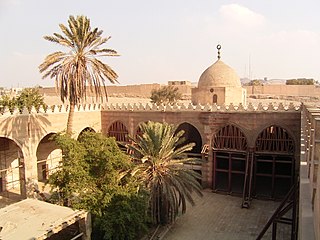 W
WThe Aqsunqur Mosque is located in Cairo, Egypt and is one of several "blue mosques" in the world. It is situated in the Tabbana Quarter in Islamic Cairo, between Bab Zuweila and the Citadel of Saladin The Aqsunqur Mosque also serves as a funerary complex, containing the mausoleums of its founder Shams ad-Din Aqsunqur, his sons, a number of children of the Bahri Mamluk sultan an-Nasir Muhammad and that of its principal restorer, Ibrahim Agha al-Mustahfizan.
 W
WThe Bayt al-Razzaz Palace or Beet El Razzaz is a mansion, in the heart of medieval Cairo, Egypt, constructed from the late 15th century through the late 18th century. The 190-room urban palace in the Darb al-Ahmar neighborhood of medieval Cairo was abandoned in the 1960s, but a restoration project rehabilitated the eastern building between 1977 and 2007. The property belongs to the Ministry of State for Antiquities which has plans to restore the western complex.
 W
WThe Beshtak Palace or Qasr Bashtak is a historic palace and museum in Cairo, Egypt, built by the Mamluk amir Sayf al-Din Bashtak al-Nasiri in the 14th century. It is located on Shari'a al-Mu'izz, in the area known as Bayn al-Qasrayn.
 W
WThe Citadel of Cairo or Citadel of Saladin is a medieval Islamic-era fortification in Cairo, Egypt, built by Salah ad-Din (Saladin) and further developed by subsequent Egyptian rulers. It was the seat of government in Egypt and the residence of its rulers for nearly 700 years from the 13th to the 19th centuries. Its location on a promontory of the Mokattam hills near the center of Cairo commands a strategic position overlooking the city and dominating its skyline. At the time of its construction, it was among the most impressive and ambitious military fortification projects of its time. It is now a preserved historic site, including mosques and museums.
 W
WThe Citadel of Qaitbay is a 15th-century defensive fortress located on the Mediterranean sea coast, in Alexandria, Egypt. It was established in 1477 AD by Sultan Al-Ashraf Sayf al-Din Qa'it Bay. The Citadel is situated on the eastern side of the northern tip of Pharos Island at the mouth of the Eastern Harbour.
 W
WDamerdash Mosque is a historical mosque originally built during the Abbasid era, in Cairo, Egypt. It is located near Damerdash Hospital which belongs to the Ain Shams University Faculty of Medicine.
 W
WThe Emir Qurqumas Complex is located in Medieval Cairo, Egypt, in the City of the dead. It is one of the largest mausoleums in Cairo.
 W
WFort Julien is a fort located on the left or west bank of the Nile about 5 kilometres (3.1 mi) north-west of Rashid (Rosetta) on the north coast of Egypt. It was originally built by the Ottoman Empire and occupied by the French during Napoleon Bonaparte's campaign in Egypt and Syria between 1798 and 1801. The fort became famous as the place where the Rosetta Stone was found in 1799.
 W
WThe funerary complex of Sultan Qaytbay is an architectural complex built by Sultan al-Ashraf Qaytbay in Cairo's Northern Cemetery, completed in 1474. It is often considered one of the most beautiful and accomplished monuments of late Egyptian Mamluk architecture, and is pictured on the Egyptian one pound note.
 W
WThe Great Iwan was a monumental throne hall located within the Citadel in Cairo, Egypt. It was built by the Mamluk sultan Al-Nasir Muhammad in the early 14th century and was considered one of the most impressive structures in the city at the time. It fell slowly into ruins over several centuries before being demolished by Muhammad Ali in 1825 to make way for the present-day Mosque of Muhammad Ali and other constructions.
 W
WThe Hammam of Sultan Inal is a historic hammam in Cairo, Egypt. It is located in the Bayn al-Qasrayn area, on al-Mu'izz street, in the historic center of Cairo. The hammam was commissioned by Sultan Inal and built in 1456, during the Mamluk period. It is one of the few well-preserved hammams in Cairo out of the nearly 80 that existed by the end of the 19th century. It recently underwent a multi-year restoration and is now open to visitors as a historic monument.
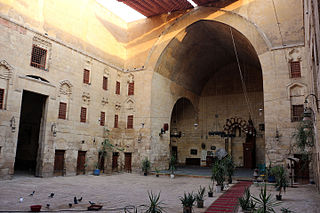 W
WThe Khanqah of Baybars II is a medieval building located on historic Sharia Gamaliya in Cairo, Egypt. It was built in 1309, in the medieval Islamic Cairo era, to accommodate four hundred Sufis and children of the Mamluks. This is the oldest khanqah, or hostel, that has survived in modern Cairo.
 W
WThe Khanqah of Faraj ibn Barquq is a religious Islamic funerary complex built by the Mamluk Sultan Faraj ibn Barquq from 1400 to 1411 CE. It is located in Cairo, Egypt, in the Northern Cemetery which is a part of Cairo's historic necropolis districts. It is often considered one of the most accomplished works of Mamluk architecture in Cairo, and one of the major monuments of the Northern Cemetery district.
 W
WThe Khanqah and Mausoleum of Sultan Barsbay or Complex of Sultan Barsbay is an Islamic funerary complex built by Sultan al-Ashraf Barsbay in 1432 CE in the historic Northern Cemetery of Cairo, Egypt. In addition to its overall layout and decoration, it is notable for the first stone domes in Cairo to be carved with geometric star patterns.
 W
WThe Madrasa of Al-Nasir Muhammad is a madrasa and mausoleum located in the Bayn al-Qasrayn area of al-Muizz street in Cairo, Egypt. It was built in the name of the Mamluk sultan Al-Nasir Muhammad ibn Qalawun, but its construction began in 1296 under the reign of Sultan Al-Adil Kitbugha, who was sultan in between Al-Nasir Muhammad's first and seconds reigns. When Al-Nasir Muhammad returned to the throne in 1299 he oversaw its construction until its completion in 1303. It is adjacent to the earlier hospital and funerary complex of Sultan Qalawun and the later Madrasa of Sultan Barquq.
 W
WThe Madrasa of Amir Sunqur Sa'di, also commonly known as the Mausoleum of (Sheikh) Hasan Sadaqa, is a medieval Mamluk-era madrasa structure and mausoleum in Cairo, Egypt. It was originally built between 1315 and 1321 CE by amir Sunqur Sa'di. Sunqur was forced to leave Egypt in his lifetime and was never buried there, but a sheikh known as Hasan Sadaqa was later buried in it and therefore the building is often known by his name. From the 17th century onward the complex was converted into Mevlevi Sufi lodge and is open today as the Mawlawiyya Museum or Museo Mevlevi.
 W
WThe cruciform Madrasah of the Amir Sarghatmish, built in 1356, lies to the northeast of the Mosque of Ibn Tulun, in Islamic Cairo. The building's school, mosque, and mausoleum can be seen from Ibn Tulun's spiral minaret, while its entrance is on Saliba Street. This structure includes a madrasa, mosque, and mausoleum. The madrasa is also referred to as the Mosque of Amir al-Sayf Sarghatmish.
 W
WThe Madrasa of Uljay al-Yusufi was built in the area between Bab Zuwayla and the Cairo Citadel during the reign of the Mamluk sultan Al-Ashraf Sha'ban.
 W
WThe Madrasa of Umm al-Sultan Sha'ban is a Mamluk-era complex located in the Al-Darb al-Ahmar area of Islamic Cairo in Egypt. It was founded or built in 1368-69 CE on the order of Sultan al-Ashraf Sha'ban in honour of his mother, Khawand Baraka. It is located outside Bab Zuweila along al-Tabbana street, and is adjoined to the north by the Bayt al-Razzaz palace. The complex is made up of a college (madrasa), mausoleum, water trough (hawd), and a primary school (maktab).
 W
WAl-Mahmoudia Mosque or the Mosque of Mahmud Pasha is a historic mosque in the city of Cairo, Egypt. It is located at the Salahuddin Square in the Citadel of Cairo area, in front of Bab al-Azab gate of the citadel. There are Sultan Hassan Mosque and Al-Rifa'i Mosque to the east.
 W
WMahmud al-Kurdi Mosque or Jamal al-Din Mahmud al-Istadar Mosque is a historic mosque in Cairo, Egypt. It was founded by an amir called Mahmud al-Kurdi who was the ustadar or majordomo of the Mamluk Sultan Barquq. It is located just south of the Qasaba of Radwan Bey which branches out from the Ahmad Maher Street, in Historic Cairo, in the district of al-Darb al-Ahmar.
 W
WThe Maristan of al-Mu'ayyad or Bimaristan al-Mu'ayyadi is a bimaristan constructed by the Mamluk sultan al-Mu'ayyad Sheikh between 1418 and 1420. It is located on the southern edge of the Darb al-Ahmar district in Cairo, Egypt, near the Citadel of Cairo and the former Bab al-Wazir gate. It did not serve its function as hospital very long and stood ruined for many years. Its facade and main walls have survived, and have been recently restored.
 W
WThe Mausoleum of Tarabay al-Sharifi is a late Mamluk funerary complex in Cairo comprising the tomb of amir Tarabay al-Sharifi as well as a sabil and kuttab, built in 1503–1504. It is located in the Bab al-Wazir Cemetery on the edge of the Darb al-Ahmar district of historic Cairo. An adjacent gate gives access from this district to the rest of the cemetery. It is considered a good example of late Mamluk architecture, combining artistic and ornamental sophistication with practical functionality in the arrangement of its different elements.
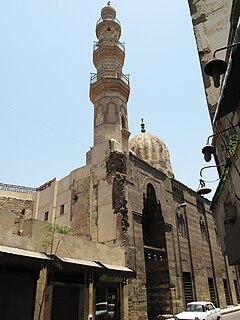 W
WThe Mosque and Khanqah of Shaykhu is an Islamic complex in Cairo built by the Grand Emir Sayf al-Din Shaykhu al-Nasiri. The mosque was built in 1349, while the khanqah was built in 1355. Shaykhu was the Grand Emir under the rule of Sultan an-Nasir Hasan.
 W
WThe Mosque and Mausoleum of Amir Ahmad al-Mihmandar which is also referred to as the al-Mihmandariyya college (madrasa) was founded during the third reign of al-Nasir Muhammad in the area of Darb al-Ahmar in Cairo.
 W
WThe Mosque of al-Zahir Baybars is a mosque built in Cairo, Egypt by the Mamluk Sultan al-Zahir Baybars al-Bunduqdari.
 W
WThe Mosque of Amir Altinbugha al-Maridani, dating from 1340 CE, is a mosque from the era of the Mamluk Sultanate of Cairo, Egypt. Located south of Bab Zuweila, in the Darb al-Ahmar neighbourhood, it was built on the outskirts of medieval Cairo by Amir Altinbugha al-Maridani, with significant help from Sultan al-Nasir Muhammad. The mosque has a hypostyle plan similar to the Mosque of al-Nasir, and its exterior walls are decorated in typical Mamluk architecture style. At the time of its building, it was one of the most extravagantly decorated mosques in Cairo, marked by the first fully octagonal minaret and large dome, as well as other architectural innovations. Its history and luxuriousness are directly correlated to the life and prominence of al-Maridani, as it was built with the patronage of his father-in-law, Sultan Muhammad and significant donations from al-Maridani's own pocket.
 W
WThe Mosque of Qani-Bay is a mosque in Cairo, Egypt. The complex is named after Qani-Bay al-Sayfi, nicknamed "al-Rammah", who was Grand Master of the Horse during the reign of Sultan al-Ghuri. It was built between AD 1503 and 1504 on a hill watching over the hippodrome and Mosque-Madrassa of Sultan Hassan. The site was chosen since the horse market and stables of the Citadel were originally located just off the square.
 W
WMosque of Qanibay al-Muhammadi is one of the historical mosques in Cairo, Egypt, built in 1413 CE during the Burji dynasty era of Mamluk Sultanate. It is located at Al-Saleeba street in Islamic Cairo, and there is Mosque and Khanqah of Shaykhu at its neighbor.
 W
WThe Mosque of Qaytbay, also known as the Madrasa of Qaytbay, is a historic religious structure in Cairo, Egypt, located in the Qal'at al-Kabsh neighbourhood. Completed in 1475, it is one of multiple monuments sponsored by the Mamluk sultan al-Ashraf Qaytbay; not to be confused with the more famous Funerary complex of Qaytbay in the Northern Cemetery. It is described as both a madrasa and a mosque by scholars, but functions as a mosque today.
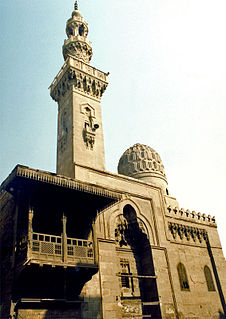 W
WThe Funerary Complex of Amir Taghribirdi or Mosque and Madrasa of Taghribirdi is a historical funerary complex of a mosque and madrasa located in Cairo, Egypt and built in the year 1440, during the Mamluk Sultanate. This monument honors Amir Taghribirdi, the mosque's commissioner and the secretary to Sultan al-Zahir Jaqmaq. The mosque and madrasa of Taghribirdi is located on a corner of Saliba street. This is not to be confused with a different Mosque of Taghribirdi, which is located in the Darb al-Maqasis neighborhood of Cairo.
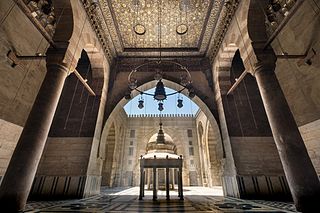 W
WMosque-Madrasa of Sultan Barquq or Mosque-Madrasa-Khanqah of Az-Zaher Barquq is a religious complex in Islamic Cairo, the historic medieval district of Cairo, Egypt. It was commissioned by Sultan al-Zahir Barquq as a school for religious education in the four Islamic schools of thought, composed of a mosque, madrasa, mausoleum and khanqah. The complex was constructed in 1384-1386 CE, with the dome added last. It was the first architectural facility built during the time of the Circassian (Burji) dynasty of Mamluk Sultanate.
 W
WThe Mosque-Madrasa of Sultan Hassan is a monumental mosque and madrasa located in the historic district of Cairo, Egypt. It was built between 1356 and 1363 during the Bahri Mamluk period, commissioned by Sultan an-Nasir Hasan. The mosque was considered remarkable for its massive size and innovative architectural components, and is still considered one of the most impressive historic monuments in Cairo today.
 W
WThe Sultan al-Nasir Muhammad ibn Qalawun Mosque is an early 14th-century mosque at the Citadel in Cairo, Egypt. It was built by the Mamluk sultan Al-Nasr Muhammad in 1318 as the royal mosque of the Citadel, where the sultans of Cairo performed their Friday prayers. The mosque is located across the street from the courtyard access to the Mosque of Muhammad Ali. The Sultan also built a religious complex in the center of the city, next to the one by his father Qalawun.
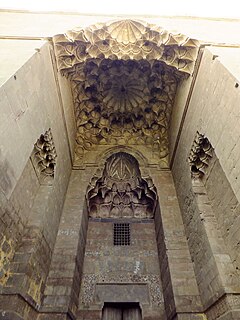 W
WPalace of Yashbak, also known as the Palace of Amir Qawsun, is a semi-ruined palace in Medieval Cairo, Egypt, originally built between 1330 and 1337 CE for the Mamluk amir known as Qawsun. It was restored and expanded again in the 1480s by the amir Yashbak min Mahdi under the reign of Sultan Qaytbay.
 W
WThe Qalawun complex is a massive complex in Cairo, Egypt, built by Sultan al-Mansur Qalawun in 1284–1285. It is located at Bayn al-Qasrayn on al-Mu'izz street and includes a hospital (bimaristan), a madrasa and his mausoleum. It is widely regarded as one of the major monuments of Islamic Cairo and of Mamluk architecture, notable for the size and scope of its charitable operations as well as for the richness of its architecture.
 W
WSabil-Kuttab of Abd al-Rahman Katkhuda is a historic monument in the historic district of Cairo, Egypt. It comprises a public fountain or sabil, an elementary Quran school or kuttab, and an adjacent residential wing. A prime example of Egyptian architecture of its time, it was commissioned in 1744 by Abd al-Rahman Katkhuda, a local official who was a prominent patron of architecture.
 W
WThe Sabil-Kuttab of Sultan Qaytbay is a Mamluk-era charitable foundation and building in Cairo, Egypt. It was built in 1479 on the order of Sultan al-Ashraf Qaytbay and is located on Saliba Street in the historic districts of Cairo.
 W
WThe Sidi Arif Mosque is one of the largest mosques in Sohag Governorate. It was built for the first time at the 14th century and was reconstructed several times; the last one was in 1968 and being renewed in 1998 for the last time. At the corners of the facade are two minarets, and the roof is crowned by a dome. Inside the five-naves mosque the bases of the piers and the walls were lined with red granite. The ceiling is painted ornamentally; in its middle is an elongated light dome. The southeastern half is lit by chandeliers. At the end there is a prayer niche (mihrab) with simple ornaments and to the right of it the wooden pulpit (minbar). A Mamluk prince's cemetery is situated inside the mosque next to the cemetery of the famous Murad Bey, who fled from Cairo after the Cairo Citadel genocide in the beginning of Muhammad Ali of Egypt era to settle down in Mamluk-controlled area of Jirja . The real name of the Arif bellah who the mosque was named after him is still mysterious to know because the term ‘arif was used by Sufi authors like Abu Abd al–Rahman al–Sulami to mean "a gnostic, mystic; a seeker of marifa ", similar in meaning to the terms salik, zahid, faqir, etc. The mosque is situated in the southern side of the city of Sohag near the main railway station and it is in the entrance of the famous old market(Souq) of Sohag, The Souk El-Qisareya.
 W
WThe Sultan Al-Ghuri Complex or Funerary complex of Sultan al-Ghuri, also known as al-Ghuriya, is a monumental Islamic religious and funerary complex built by Sultan Qansuh al-Ghuri between 1503 and 1505 CE. The complex consists of two major buildings facing each other on al-Mu'izz li-Din Allah street, in the Fahhamin Quarter, in the middle of the historic part of Cairo, Egypt. The eastern side of the complex includes the Sultan's mausoleum, a khanqah, a sabil, and a kuttab, while the western side of the complex is a mosque and madrasa. Today the mosque-madrasa is still open as a mosque while the khanqah-mausoleum is open to visitors as a historic site.
 W
WThe Sultaniyya Mausoleum is a Mamluk-era funerary complex located in the Southern Cemetery of the Qarafa, the necropolis of Cairo, Egypt. It is believed to have been built in the 1350s and dedicated to the mother of Sultan Hassan. It is notable for its unique pair of stone domes.
 W
WThe mosque and tomb of Salar and Sangar al-Gawli is located near the Ibn Tulun Mosque along Saliba Street in Medieval Cairo and is west of Madrasa of Sarghatmish. It contains the joint mausoleums of Sayf el-Din Salar and Alam el-Din Sangar el-Gawli, powerful Mamluk emirs in the early 14th-century in 1304. The latter built the complex which also contains a madrasa for the Shafi'i school of jurisprudence and khanqah for the Sufi community.
 W
WThe Wikala and Sabil-Kuttab of Sultan Qaytbay is a complex of monuments built by the Mamluk sultan Al-Ashraf Abu Al-Nasr Qaitbay in 1477 CE in Islamic Cairo, the historic medieval district of Cairo, Egypt. The complex consists of an urban caravanserai, a water dispensary (sabil), a water trough (hod), and a school (kuttab). It is located just south of Al-Azhar Mosque.
 W
WThe Wikala of Sultan Qansuh al-Ghuri is a caravanserai in the medieval center of Cairo, Egypt. It was built in 1504–1505 CE and is considered today one of the most impressive and best-preserved examples of this type of building in Cairo.
 W
WThe Wikala of Sultan Qaytbay or Wakala of Sultan Qaytbay is an urban caravanserai and rab built by Sultan al-Ashraf Abu al-Nasr Qaitbay in 1481 CE in Islamic Cairo, the historic medieval district of Cairo, Egypt.